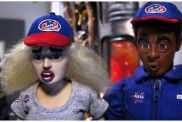
Mira Nair’s Amelia is no more a story of the famed aviatrix Amelia Earhart as it is a standard by-the-book fourth grade telling of her life. Starting from the end and then giving us the Cliff’s Notes on how she got there, Nair’s film never once attempts to dig into what makes Earhart’s story a story worth telling and instead just boils down to a woman that flew planes and got married. She’s inspirational because we’re told so and she’s quite poetic when it comes to describing her time in the air as Hilary Swank’s banal voice over reminds us every five minutes.
Swank stars in the title role, a role assumed to be a likely third Oscar nomination for the two-time winner as soon as it was announced, but now she may be struggling to even appeal to the Hollywood Foreign Press. Swank’s performance is nothing more than a smile and an accent creating a character going from point A to point B with definite determination, but without much zeal or interest. The only real life in this film is Gabriel Yared’s score, which is only given a chance to shine when all characters are off the screen and the beautiful camerawork of Stuart Dryburgh takes over.
However, Nair’s films are always beautiful and Amelia is no exception. Whether it’s a shot of Earhart’s Electra soaring over brilliant canyons or a simple look at a wind swept wheat field, there is beauty here and Yared’s score, when uninhibited by Swank’s voice over additions, works hand-in-hand with the golden scenery.
Here in lies the problem, Amelia is presented like a nature photographer’s portfolio, focused on natural beauty and the romance of it all. We watch as Earhart is wooed by one-time promoter/publisher-turned-husband George Putnam played with agonized joylessness by Richard Gere, while the story completely overlooks her affair with the smiling founder of TWA, Gene Vidal (Ewan McGregor). Instead the Earhart/Vidal relationship is limited to an elevator smooch and a one-line dismissal. Passion averted. Scandal ignored. Tedium continues. We end up with a wax figure of a lead character with the guts of her story completely removed.
The film bounces back-and-forth following Earhart’s doomed final flight around the world, to the past where she reluctantly sells luggage and her own clothing line. She does this, Putnam explains, so they can fund her flying. And why does she fly? Because she wants to and it is fun, she says, too bad the film doesn’t follow suit.
Amelia is too safe. Watching it you would assume nothing outside of a few flights across the Atlantic defined who Amelia Earhart was. Based on this film I would believe she was just as much a National Geographic journalist as she was an adventurous pilot viewed as a symbol of feminism and an American icon lost to a tragic accident.
As the film and Yared’s score swells in the final moments you hope Nair will treat her subject with some sense of gravitas. Instead she ekes out every last bit of forced drama she can even though the audience is already twelve steps ahead and hardly interested in the cardboard cut-out of a character portrayed on screen. If this is all there is to know about Earhart, her life may have been a subject best left alone.










